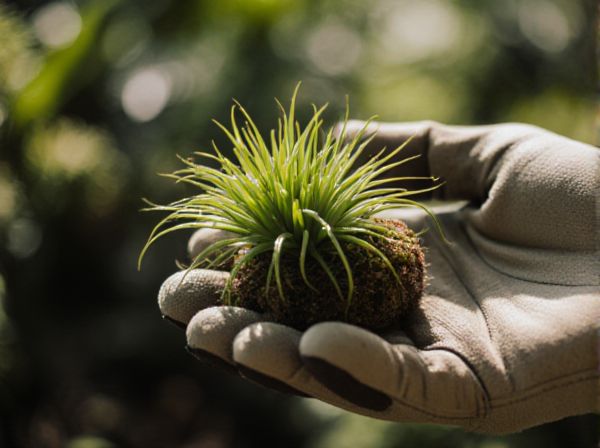
Epiphyte vs Lithophyte Illustration
Epiphytes grow on other plants, primarily trees, extracting moisture and nutrients from the air and debris, whereas lithophytes thrive on rocks, obtaining nutrients from rainwater, dust, and organic matter accumulated in crevices. Both types of plants adapt to nutrient-poor environments but exhibit different rooting strategies and support systems. Understanding the distinction helps in studying plant ecology and adapting gardening techniques for diverse habitats.
Table of Comparison
| Feature | Epiphyte | Lithophyte |
|---|---|---|
| Definition | Plant that grows on another plant non-parasitically | Plant that grows on rocks or stony substrates |
| Root System | Adapted to anchor on plant surfaces and absorb moisture from air | Adapted to cling to rock surfaces, extracting nutrients from minimal soil |
| Examples | Orchids, Bromeliads, Mosses | Saxifraga, Sedum, Lithops |
| Habitat | Tropical and subtropical forests, high humidity areas | Rocky outcrops, alpine zones, arid regions |
| Nutrient Source | Absorbs nutrients from rain, debris, and air | Extracts minerals from rock surface and surrounding debris |
| Water Absorption | From air moisture, rain, and organic debris | From rainwater collected on rocks or crevices |
| Ecological Role | Enhances biodiversity by providing habitats for other species | Prevents soil erosion by stabilizing rocky areas |
Understanding Epiphytes and Lithophytes
Epiphytes are plants that grow on other plants, deriving moisture and nutrients from the air and rain without harming their host, while lithophytes establish themselves on rocks, obtaining minerals through their root systems from crevices and substrates. Both epiphytes and lithophytes exhibit specialized adaptations such as aerial roots or minimal soil dependence to thrive in nutrient-poor environments. Understanding these growth strategies reveals their ecological roles in biodiversity and nutrient cycling within ecosystems.
Key Differences Between Epiphytes and Lithophytes
Epiphytes grow non-parasitically on other plants, primarily trees, deriving moisture and nutrients from the air and rain, while lithophytes anchor themselves on rocks, obtaining nutrients from rainwater, dust, and nearby organic material. Epiphytes often have specialized root adaptations for clinging onto bark and absorbing atmospheric moisture, whereas lithophytes develop strong root systems to penetrate rock crevices for stability and nutrient absorption. These differences highlight their distinct ecological niches and survival strategies in plant biology.
Growing Conditions for Epiphytes vs Lithophytes
Epiphytes thrive by growing on other plants, mainly trees, relying on air moisture and organic debris for nutrients, making them well-suited for humid, sheltered environments with ample airflow. Lithophytes develop on rocky surfaces, extracting nutrients from rainwater, decomposed rock material, and minimal organic matter, adapting to exposed conditions with variable moisture and sunlight. These contrasting growing conditions highlight epiphytes' preference for moist, shaded habitats and lithophytes' resilience in harsh, nutrient-poor, and sun-exposed areas.
Popular Epiphyte Plants for Gardeners
Popular epiphyte plants for gardeners include orchids, bromeliads, and air plants, which thrive by absorbing moisture and nutrients from the air and surrounding debris. Unlike lithophytes that grow on rocks, epiphytes prefer tree branches or trunks, making them ideal for vertical gardening and indoor displays. Their unique adaptations allow them to flourish without soil, adding aesthetic value and biodiversity to gardens.
Top Lithophyte Species for Home Gardens
Top lithophyte species for home gardens include ferns like Asplenium nidus, known for thriving on rocky surfaces with minimal soil. Succulents such as Sedum and Sempervivum adapt well to lithophytic conditions, offering drought resistance and unique textures. Incorporating these plants enhances garden biodiversity while optimizing space on stone walls and rock gardens.
Watering Needs: Epiphytes vs Lithophytes
Epiphytes require frequent misting and light watering as they absorb moisture from the air and rain, thriving in well-draining environments that mimic their natural canopy habitats. Lithophytes need less frequent watering, relying on moisture trapped in rock crevices and benefiting from excellent drainage to prevent root rot. Understanding these differences in hydration is crucial for maintaining optimal growth and health for both plant types.
Soil and Substrate Requirements
Epiphytes absorb moisture and nutrients directly from the air, rain, and debris accumulating around their roots, thriving without soil. Lithophytes grow on rocky surfaces, extracting nutrients from minimal organic matter and crevices in the substrate. Both plant types require well-draining environments but differ significantly in their dependency on soil, with epiphytes typically avoiding soil altogether while lithophytes tolerate thin soil layers on rocks.
Light Preferences and Adaptations
Epiphytes, such as orchids and bromeliads, thrive in filtered sunlight within tree canopies, showcasing adaptations like aerial roots for moisture absorption and minimal soil dependence. Lithophytes, including certain ferns and saxifrages, prefer direct or partial sunlight on rock surfaces and exhibit specialized root systems that anchor into crevices while extracting nutrients from limited substrates. Both plants have evolved distinct strategies to optimize light capture and nutrient uptake in challenging environments.
Common Challenges When Growing Epiphytes and Lithophytes
Epiphytes and lithophytes face common challenges such as moisture retention, nutrient acquisition, and proper air circulation due to their unique growth habits on other plants or rocks. Both types require carefully monitored humidity levels and frequent misting to prevent desiccation, while ensuring substrates drain well to avoid root rot. Adequate light intensity and protection from direct sun exposure are critical to support photosynthesis without causing leaf burn or stress in epiphytic and lithophytic plants.
Choosing Between Epiphytes and Lithophytes for Your Garden
Epiphytes, such as orchids and bromeliads, thrive by growing on trees and absorbing moisture from the air, making them ideal for humid environments or indoor gardens with indirect light. Lithophytes, including certain ferns and succulents, grow on or among rocks, requiring well-drained conditions and benefiting gardens with rocky landscapes or dry climates. Choosing between epiphytes and lithophytes depends on the available space, humidity levels, and substrate type within your garden, ensuring optimal growth and reduced maintenance.
Epiphyte vs Lithophyte Infographic

 gardendif.com
gardendif.com